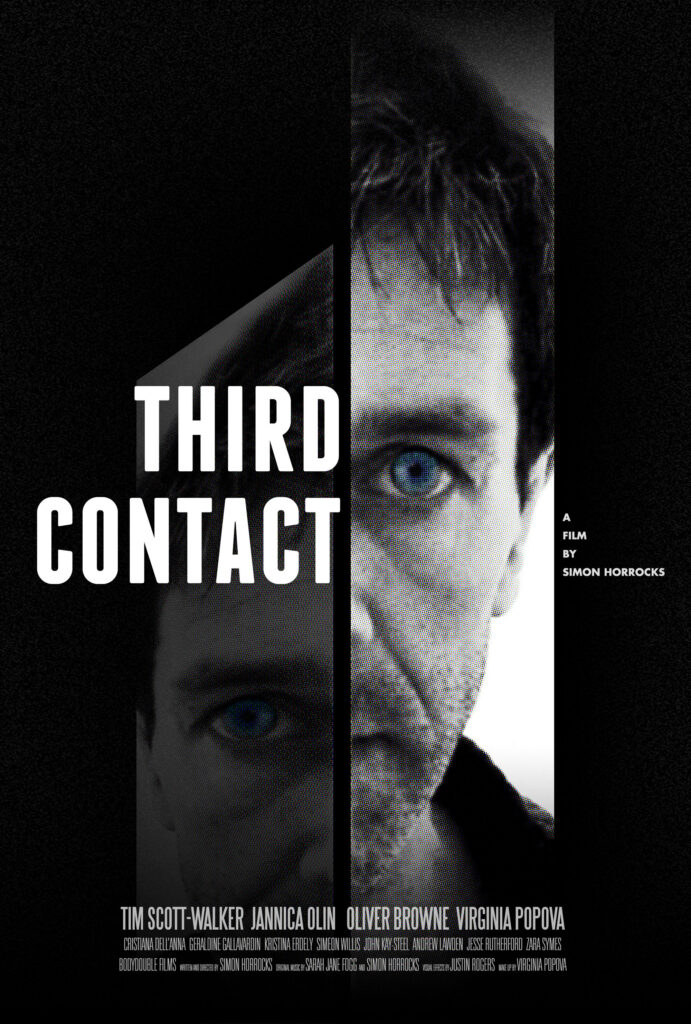Third Contact Movie Review

Simon Horrocks low budget Sci-fi Thriller, Third Contact (2011) went down a storm last night at London’s Waterloo IMAX cinema. Not only does Horrocks raise awareness about the issues surrounding mental health he effectively demonstrates an intellectual insight into depression. Third Contact immediately breaks the traditional rules of Hollywood with the absence of an establishing shot. Instead, the audience is transported into a deep conversation about quantum suicide between a therapist, Doctor David Wright, and his patient. Tim Scott- Walker’s convincing portrayal as the tormented therapist Doctor Wright, allows the audience to connect with the disoriented character.
Horrocks filming techniques reminded me a lot of the pioneering filmmaker, Jean Luc-Godard. The low budget, the decision to edit the film in black and white, and the use of handheld cameras, are just some of the reasons why. Similar to Godard, Horrocks purposefully created confusing and chaotic sequences that shrewdly leave the audiences guessing. In addition Horrocks also utilizes filmmaking in order to express and explore mental illness and the key ideas of existentialism such as despair, angst, and facticity. Godard frequently explored the norms and values of society, and the notions of death.
A sense of Film Noir shines throughout the story with Horrocks bold decision to edit the film in black and white, which positively impacts the mise en scene. Diegetic and non-diegetic sound is used to heighten and shape the poetic mood of the narrative. The actors convey emotions and thought through the use of body language and facial expressions when there are little or no dialogue sequences. Lighting is used to create a dramatic contrast between lightness and darkness.
Props are intelligently used by Horrocks, with empty photographs frames dotted around several interior scenes. The picture-less frames connotes the characters are lost, unknown, empty and unrecognizable figures. Most importantly it is a direct reference to memories, which is another key theme that runs throughout the narrative. Photographs have the ability to preserve history. Not only does the physical evidence help to protect someone’s memories, photographs are a great method used to illustrate someone’s life story. Photos can evoke emotions from the protagonist concurrently they invite others to share your memory, even if they were not present at the time. Characters are unable to share each other’s memories in the Third Contact with most of the photographs being absent. Additionally the protagonists lack the physical evidence that proves that their memories are, in fact, real and not a figment of their imaginations.
A regular patient of Dr. Wright is shown crafting a children’s doll at his workplace. As one life ends another life is being born, although the life is that of a doll this scene still exemplifies the concepts of life and death.
Suicide is a prominent subject, running from beginning to the end of the film. If somebody thinks about committing suicide or attempts to take their own life, it is a clear indication that something is wrong in a person’s life. Why do people commit suicide? Does depression steer people into wanting them to take their own lives? Can an individual single-handedly encourage somebody else to end his or her life? Or is it society as a whole that drives people into such disappear, that they are left little choice but to depart this life? Suicide is a dark and complex subject to understand as each case is complex in its own way. These are the questions that Horrocks raises throughout the film.
Third Contact kept me entertained for a whole ninety-nine minutes, as a vast amount of time and research has evidently gone into writing this script, it is far from being over-scripted or predictable. The non-linear narrative captivates the audience as it forces them to work hard in order to unravel the plot. Although Third Contact can be compared to other films, it maintains its originality and manages to keep an edge over its predecessors.
As an aspiring scriptwriter and filmmaker, I have studied Film, television and New Media for the last six years. I know how difficulties arise during pre-production, production, and post-production. I have nothing but admiration for Simon Horrocks as he successfully taught himself how to write scripts, film, overcome budgets and how to edit. Horrock’s determination and passion for this film has definitely paid off, Third Contact is stimulating and intriguing. Long gone are the days where Horrocks used to sell popcorn to movie goers, instead he will be selling cinema tickets for people to watch his own films, as he can now proudly call himself an independent filmmaker.
I would definitely recommend for others to watch.I rate Third Contact an impressive five stars out of five.
Written By
Hannah Crawford

